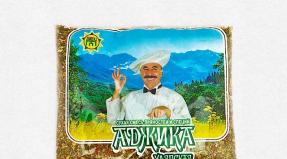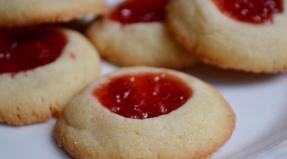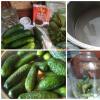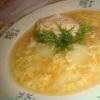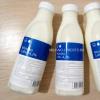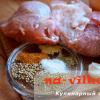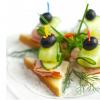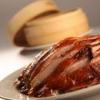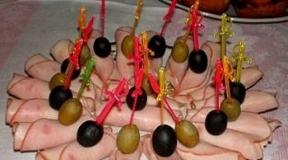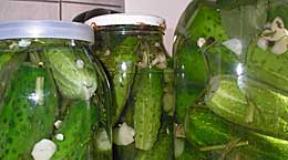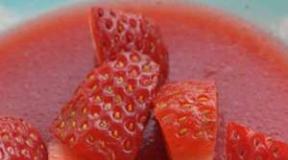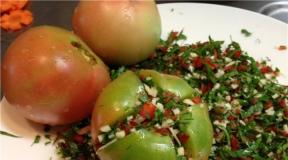Cooking dried fruits from prunes. How to make prunes at home
All of us, without exception, constantly buy dried fruits on the market - raisins, dried apricots, prunes, figs. Undoubtedly, it is very convenient, fast and almost always available, because there are departments with dried fruit in every supermarket. It is not always true that the quality and price of dried fruit fits certain parameters, and it also happens that by purchasing a handful of two raisins or dried apricots, even in the refrigerator, they are covered with mold bloom, thus indicating a violation of the production drying technology ...
And you do not want to try to make one of the most popular dried fruits - prunes at home? The simplest process that will amaze with the result, because homemade prunes cannot be compared with the store analog! It has the most pronounced deep fruity taste, amazing plum aroma and great density. In addition, dried prunes at home are devoid of harmful additives and wax, with which they process the dried fruit in industrial dryers for longer storage. Recipe with photos of prunes made at home, which can be fearlessly eaten by everyone without exception - already on our website!
To make prunes in the oven will need (output - 1.5 kg):
- fresh plum "Hungarian" - 2 kg
- sugar - 200-250 g
How to make prunes at home - a simple recipe:
Plum varieties "Hungarian" take a ripe, non-acidic, but always dense. You can try other varieties that also have a sweet elastic flesh, but the “Hungarian” will still be ideal for homemade prunes. In such a sink, the bone is well separated, which is what we need! We wash the drain, separate the tails, leaves and all the other unnecessary.

Carefully prune the groove on each side on each side so that you can remove the bone without dividing it into two halves. You should get these "shells".

In each plum-shell pour a teaspoon (or how much will fit) sugar. Take the pan and the first layer on the bottom put all sugar-filled plums.

Fill the pan to the top in the same way, sprinkle a little sugar on top. Leave for a day. Periodically, shake the pan so that the resulting syrup dissolves the sugar as much as possible.

A day later, sugar and plum juice form a liquid syrup. It will not be too much, it will not cover the drain completely, but we do not need it.

Put the plum with syrup on a small fire and bring to a boil. We do not boil the plums, mix them in a hot syrup a couple of times and immediately remove them from the heat after the first signs of active boiling appear. The fruits will only warm up and slightly change the shade from blue-black to reddish-plum. Drain plums in a colander and separate the syrup from it.

Now we take a baking sheet, we cover it with parchment, we spread the heated plum in rows, leaving a little space between it.

Begin to wilt. The drying process will be done in the oven, so if you have a home kitchen electric dryer, you can use it according to the instructions. The oven is heated to 60-70 degrees and put the baking sheet in the middle position, opening the door and fixing a small crack with a wooden spatula. The cooking time for prunes at home in the oven is individual, depending on the size, variety of plums, on average from 4 to 8 hours.

In the process, it is necessary to turn the drain on the other side so that it is dried on all sides. The readiness of the plum is determined by the following features: it should not be wet, but become elastic and dense.

When the drain is dry enough - soak it for 2-3 days in a room, on the kitchen window sill or on the sunny balcony for the final result.

Prunes at home ready!

Now you can use it for its intended purpose - just use it as a useful snack, add to cereals, desserts and pastries.

Enjoy your meal!
Gleaming with glossy sides, prunes lying on the shelves of shops, and calls for more to buy it and, of course, ate. But we know what this “gloss” was created with and therefore a beautiful type of dried fruit does not seduce us. It is quite understandable that, treated with glycerin, sulfur compounds, or liquid smoke, the "sparkling" prunes almost completely lost their beneficial properties. And if the purchase of dried fruit is still planned, then it is better to purchase the product without a bright "color" and a more natural look. And if the fear of buying is still strong, then there is, perhaps, the only way out - to cook natural prunes at home. On how to make prunes with your own hands, we now will advise you.
 How to make prunes at home
How to make prunes at home
Naturally, first of all we will deal with the selection and preparatory processing of fresh fruits. For the process of making dried prunes, we need to pick up very ripe, even better overripe, plum fruits.
Selected fruits, of course, are thoroughly washed first and, if desired, we remove the bones. It should be noted that prunes at home can be done, as without stones, and with stones. True, leaving a seemingly unnecessary bone, we will store much more useful substances in dried prunes.
After blanching, we immediately wash our plums with hot water and proceed to the process of drying prunes.
To dry our prepared plum fruits, we will, of course, be in the oven! That's just to monitor the temperature of the process, we will be very careful to get our prunes not only tasty, but also useful.
Since the procedure of drying fruits in the process, how to make prunes at home, is the most important, let us, for convenience, divide it into three stages.
 Stage One
Stage One
Fold the plums on a baking sheet and, putting it in an oven preheated to 50 degrees, dry the fruit for 3-4 hours.
 Stage Two
Stage Two
We get out of the oven pan. Mix plums (carefully, they are hot) and cool. After the fruits have completely cooled, we heat up our oven to 70 degrees and place a baking sheet with plums for another 5 hours.
 Stage Three
Stage Three
Removing a baking sheet from the oven, repeat the previously performed actions (stir and cool). We bring the temperature in the oven to 90 degrees and, having placed a baking sheet in it, we dry our homemade prunes until ready, spending 4 hours more on it.
That's all our advice on how to make prunes at home.
 to get the shiny surface of dried fruits it is not necessary to process them with anything. If, shortly before the fruit is dried in the oven, the temperature is increased to 120 degrees, then the sugar that has come out of the fruit caramelizes dried fruits and gives their surface gloss without the use of any “chemistry”.
to get the shiny surface of dried fruits it is not necessary to process them with anything. If, shortly before the fruit is dried in the oven, the temperature is increased to 120 degrees, then the sugar that has come out of the fruit caramelizes dried fruits and gives their surface gloss without the use of any “chemistry”.
 Naturally, making prunes, it is also important to provide him with the necessary conditions for storage. It is necessary to store cooked prunes, either by packaging them in paper bags, or by placing them in wooden boxes. You can, of course, keep dried fruits in a closed glass container, but for this, prunes must be 100% dry. Some housewives use bay leaves, sprinkling dried fruit with a small amount of bay leaves.
Naturally, making prunes, it is also important to provide him with the necessary conditions for storage. It is necessary to store cooked prunes, either by packaging them in paper bags, or by placing them in wooden boxes. You can, of course, keep dried fruits in a closed glass container, but for this, prunes must be 100% dry. Some housewives use bay leaves, sprinkling dried fruit with a small amount of bay leaves.
 You can, of course, ridding yourself of unnecessary trouble, buy prunes in the bazaar or in the store, but if you know how to make prunes at home, why put yourself and your loved ones at possible danger. And yet, decide for yourself!
You can, of course, ridding yourself of unnecessary trouble, buy prunes in the bazaar or in the store, but if you know how to make prunes at home, why put yourself and your loved ones at possible danger. And yet, decide for yourself!
Dried plums are probably the most famous and popular dried fruit, except raisins. Prunes are not only beneficial for health, but also very versatile in the kitchen. It perfectly complements both sweet and meat dishes. This dried fruit is also popular as an ingredient for, as an additive in muesli, yogurt and.
Purchased prunes are often treated with sulfur and other preservatives to preserve the best color of the fruit and longer storage. Sulfur can cause headaches, nausea, vomiting and diarrhea in sensitive people. In addition, it is a real killer of vitamin B 1.
Therefore, it is always safer to dry the plums yourself, using a special dryer (dehydrator) or a conventional oven. Only in this case, you get a guaranteed natural product without any additives. Usually, the result is very good, even with the most inexpensive models of dryers.
It is believed that real prunes do not come from any plums, but only from special varieties - Italian Hungarian, Hungarian homemade, Hungarian Pokrovka, Renclod. Owners of plums of other varieties do not interfere, as well as dry their fruits. It turns out not quite familiar purchased prunes, but completely natural.
Drying plums ensures the safety of fruits and saves storage space. When dried, a bucket of fresh plums will turn into a couple of prune cans. And they can easily find a place, even in conditions of limited space. In addition, there is another reason for cooking homemade prunes.
Prunes for health
From the point of view of health, prunes and fresh plums, at first glance, hardly have any outstanding nutritional value. The content of vitamins, minerals and trace elements is extremely low. Why, then, prunes is considered very useful?
Prunes are the absolute record for the content of antioxidants among all fruits and vegetables. Therefore, dried plums are very valuable for their ability to support the work of the immune system and detoxification organs.
There are scientific studies that talk about the contribution of prunes in the protection of intestinal health. In particular, regular use of this product provides the intestines with fiber well and is considered effective in preventing colorectal cancer.
Prunes are made wonderful home remedy for constipation. To do this, put 3-4 prunes in a glass of water and leave overnight. In the morning they drink plum water and eat soaked prunes. The laxative effect of prunes due to the high density of vegetable fibers and the presence of fructose. Prunes are also used during pregnancy as a natural, well-tolerated mild laxative.
Fructose is rapidly converted to energy in the body. Thus, prunes can quickly fill the body with forces in a state of exhaustion.
In folk medicine, the therapeutic value of prunes has been highly appreciated for many centuries. In addition to the already mentioned anti-tumor and laxative effects, prunes are also useful for:
- supporting kidney and liver function;
- reduce fever;
- prevention of atherosclerosis;
- stimulation of metabolism (therefore also suitable for weight loss);
- relieve rheumatic pains and gout.
The process of drying plums
In the dehydrator, or oven, a large amount of water evaporates from the fruit. Bacteria and various microorganisms live in a moist environment, they need it for life, the formation of rot and mold. In the dried product they have no place. Therefore, dried plum is stored for a long time, has only a small amount of residual moisture and feels a little soft to the touch.
The difference with purchased prunes is that sulfur and other additives are not added to homemade prunes. Also, a greater amount of nutrients, including enzymes, is stored in the dried plum.
Recipe hcutting out in a dryer or oven
This is important: The recipe for dried plums does not imply the use of a sweetener. Therefore, depending on the variety, the end result may not be very sweet. If you are not confused by the addition of sugar to prunes, then watch and follow the recipe in the video at the very bottom of the page.
Ingredients:
Fresh plums
Cooking:
1. Wash the plums. Incise each plum with a knife, but not completely, and pull out a bone.
2. In the dryer: distribute the fruit on the pallets with the cut upwards to facilitate the evaporation of moisture.
In the oven: Put the plums on a baking sheet covered with baking paper. 3
. In the dryer:
dry plums in the dryer at 40-60 degrees. It is believed that for greater preservation of nutrients, the temperature during drying should not exceed 42 degrees. Duration of drying is individual, lasts, on average, about 24 hours.
3
. In the dryer:
dry plums in the dryer at 40-60 degrees. It is believed that for greater preservation of nutrients, the temperature during drying should not exceed 42 degrees. Duration of drying is individual, lasts, on average, about 24 hours.
In the oven: Allow plums to dry at 50-60 ° C for 15-17 hours. It is important to ensure good air circulation so that the moisture from the drain evaporates properly. Even if the oven is with convection, it would not hurt to clamp the wooden spoon with the oven door. After drying, let the plums cool well.
4. Put the finished prunes in glass jars, close the lid and stick a label with the name and date of preparation.
Many people love prunes, which you can buy all year round on the market. It is a very useful product and has been used in cooking for more than one century. Unfortunately, not everyone decides to cook it at home, but this method makes it even more filled with vitamins.
When for the first time a person came up with the idea to dry a finished plum in the sun, no one can reliably say, but the fact that this was done so many years ago is a fact. Historical documents show the characteristics of prunes, and they are dated as early as the 6th century BC.
Everyone knows that sweet plums are used to make seaming - prunes. To do this, it is washed and dried in the sun. If weather conditions cannot ensure a normal process, this can be done in a stove or oven. When the oven is used, prunes become especially tasty, with the best flavor, largely due to the smoldering wood.
Unfortunately customers, not all manufacturers adhere to the correct technology of cooking prunes. Today it is possible to achieve the highest possible result with the help of liquid smoke and other chemicals. That is why it is recommended to cook fresh product at home, so that year-round prunes of own production are produced.
Delicious prunes are always made from good ripe fruit. It is believed that there is a special sweetness and fleshyness in those fruits that are sown the most recent. Among the most common varieties are Hungarian, Kroman, Naroch, Stanley and others.

Useful qualities of this product are in its content:
- Potassium;
- Pectin;
- Vitamins A, C, B, P;
- Calcium;
- Phosphorus;
- Iron;
- Sucrose, fructose and glucose;
- Citric, salicylic and malic acid.
All of them have a positive effect on human health and his general condition.
First you need to prepare the plum, so that you get a quality product. Choosing the right fresh fruit is very important - they must be ripe, you can even overripe.
They require thorough rinsing and pitting. Although you can not remove them (after all, even on the market you can buy prunes with stones as well as without stones). It is believed that their preservation in the sink leaves it all useful substances.
Already peeled fruits are blanched in soda solution (temperature - 90 degrees) for about half a minute. At the same time per 10 liters of water accounts for 100 grams of soda. When the blanching is over, the drain is well washed and dried. This should occur in the oven, however, the process requires special supervision so that the prunes turn out to be tasty and all useful properties remain in it.
To obtain a quality product, you should carefully disassemble each stage of preparation:

- Washed plums razlazhivayutsya on the baking sheet and sent to the oven for 4 hours at a temperature of 50 degrees;
- After the plums are stretched, they should be gently mixed so that they do not deteriorate because they are very hot. When they cool down, they must again be dried in the oven for 5 hours. The temperature should already be 70 degrees;
- The plums are again cooled and dried in the oven at a temperature of 90 degrees for about 4 hours.
To prunes had a smooth glossy surface, you do not need to apply any additional chemicals. To do this, shortly before the end of cooking, make the temperature in the oven at 120 degrees. This leads to the caramelization of the fruit, which makes the peel glossy.
For long-term storage, dried fruits are packaged in paper bags and wooden boxes. If there is only glass packaging, the prunes must be completely dry. Sometimes bay leaf is used in banks for the same result.
If the plum is large enough, then the bones should be removed. If it is small or medium size, it is recommended to get rid of them.

The output of prunes in 1 kg is obtained after drying 4.5 kg of fresh fruit.
On a baking sheet it is better to lay out plums with a cut up.
The drying process usually takes about 12 hours, and between each stage you need to take a break of 5 hours.
The resulting product is at the same time soft and resilient, so that pressing does not cause the release of juice.
Although cooking prunes at home takes time, the result is worth it. Indeed, the mistress is sure that he does not contain chemicals, it is of high quality and will not harm a person.
Dried prunes - a tasty and healthy dried fruit, which is sold in stores all year round. Cost, and the quality of the goods is not always satisfied with the buyer. Therefore, for fans of prunes there is great news - plums can be prepared in advance and then used for cooking various dishes.
How to dry prunes - which plums are suitable
To get very tasty and healthy prunes, you need to choose the right plum for drying. Namely, ripe “Hungarian” is suitable, the variety may be called “Hungarian” or “Italian Hungarian”. This plum variety has a very dense skin and flesh. Just what you need for drying. In addition, the "Hungary" more sugar than other varieties of plums and not so much acid. An ideal grade not only for drying, but also for preparations for the winter because the stone is easy to separate without damage. By the way, any variety of "Hungary" is suitable for drying. If you come across a variety of "Hungarian violet" or "Azhanskaya", feel free to proceed to the procurement.
How to dry prunes - preparation of plums
It is known that elastic, mature and intact fruits are suitable for winter preparations. Plums will have to be plucked from the branches, and not to shake the tree, then to collect the plums that fell to the ground. If no other option is provided, then you can trot a branch somewhere in the afternoon. Over-ripe plums will fall to the ground (they can be used for jams and preserves), rotten ones (they will have to be thrown away) and immature. In the morning, a favorable period for picking ripe fruits begins.
Collected plums should be folded in a basket with holes, left in a well-ventilated room for 3 days.
Sorting: ripe and intact plums are selected, trapped, rotten and spoiled are thrown away. Leaves and peduncles must be removed, the bones must be carefully removed. Plums are expanded in size so that the halves are approximately the same size.


How to dry prunes
You can dry the plum both in the oven and in a special electric dryer. Not every housewife has such an appliance, but an oven is installed in every apartment or house. Therefore, the easiest way to learn how to dry the plum in the oven.
How it is done correctly:
- to get 1 kg of dry finished product, you will need to prepare approximately 4.5 fresh enumerated plums;
- to speed up the drying process, the plums can be pre-blanched: immerse in boiling water with the addition of soda (15 g per 1 l of liquid) for literally 30 seconds, quickly remove, immediately rinse thoroughly in cold water. To do this, cook a pan with cold water and put it next to the stove;
- if everything is done correctly, the result of the work will immediately manifest itself: the skin of the plums will be in a fine mesh. Just what you need in order to get rid of excess moisture during drying;
- if the first pancake turned out to be lumpy and large cracks appeared on the surface of the plums or even “the skin got off”, this means that it is necessary to reduce the blanching time and instead of 30 seconds, hold the plums in boiling water for 20 seconds;
- after blanching is done, the plums can be dried. This can be done as follows: prepare baking trays for drying in the oven, lay baking paper, spread out the plums in 1 layer so that the drain "looked" cut up;
- drying temperature 45 degrees, duration - 3 hours. You will notice that the skin will begin to shrink gradually. Just after 3-4 hours of draining drying, you can raise the temperature and set the oven timer to 80 degrees (this is the maximum), dry for 10 minutes. Then the oven must be turned off and left the plums for 5 hours, until it is completely cooled;
- then repeat the steps and so on for 3 days. The last stage of drying is 2-3 minutes in the oven at the maximum (temperature 100 degrees). This is necessary in order to stand out the sugar and caramelize at high temperature.
Ready prunes - soft and elastic, and if you press down - then the juice should not stand out.

